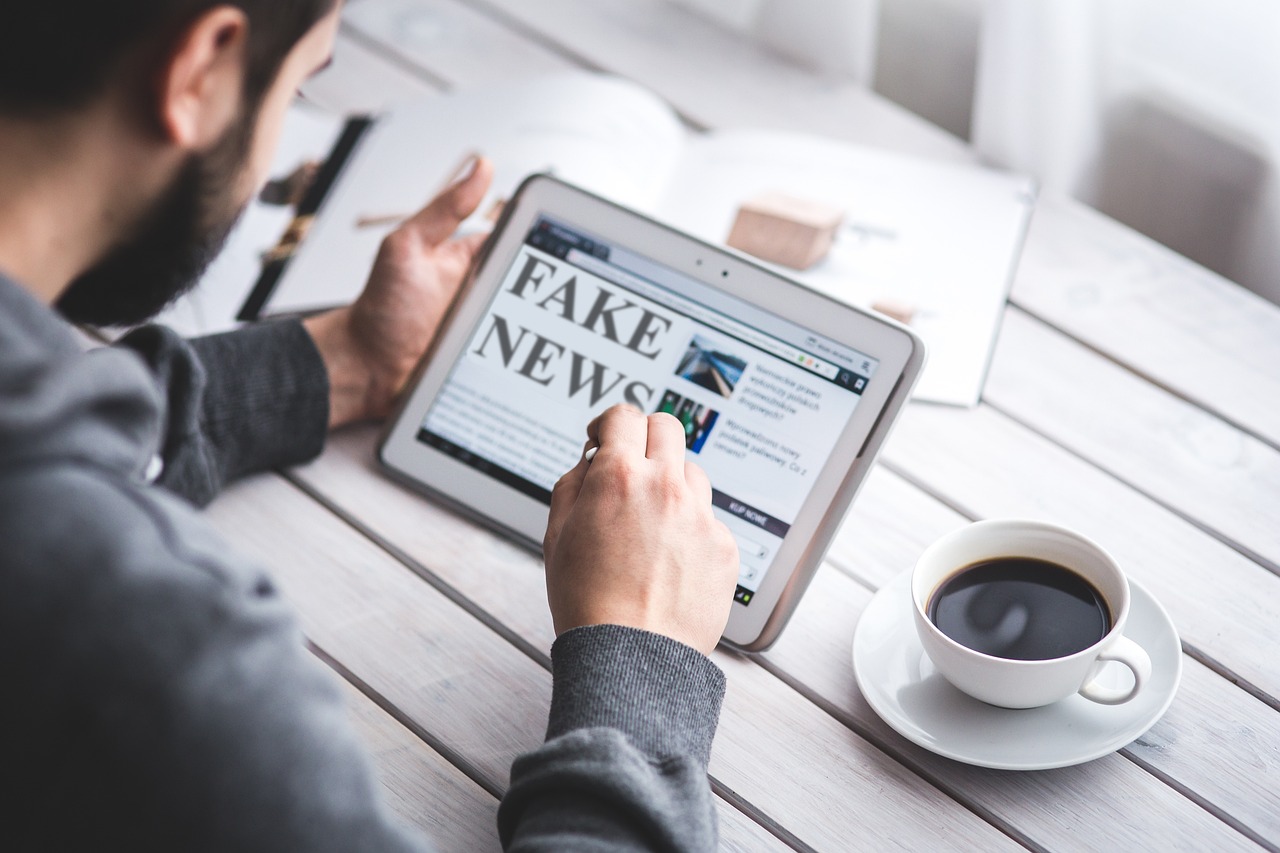Don’t Fall for It: Unmasking Online Fake News
In today's digital era, the term fake news has become a buzzword that we hear almost daily. But what does it really mean? Fake news refers to information that is deliberately fabricated and presented as if it were legitimate news. It’s like a wolf in sheep's clothing, cleverly disguised to deceive the unsuspecting reader. As we navigate through an overwhelming sea of information online, it's crucial to understand the characteristics of fake news to protect ourselves from its harmful effects.
The proliferation of fake news is not just a minor inconvenience; it poses a significant threat to our society. Imagine a world where misinformation can shape public opinion, sway elections, and even incite violence. The impact of fake news is profound and far-reaching. It doesn’t just confuse individuals; it creates a ripple effect that can polarize communities and erode trust in reputable news sources. When we can’t tell what’s real from what’s fabricated, we lose our ability to make informed decisions.
But why do people fall for fake news? The answer lies in our psychology. Our brains are wired to seek out information that aligns with our beliefs, a phenomenon known as confirmation bias. This bias leads us to accept information that confirms our existing views while dismissing anything that contradicts them. It’s like wearing blinders that prevent us from seeing the full picture. Furthermore, fake news often plays on our emotions—fear, anger, and joy—making it more likely to be shared and believed. When we encounter an article that evokes a strong emotional response, we’re more inclined to share it without verifying its authenticity.
Social media platforms serve as the primary breeding ground for fake news. With algorithms designed to maximize engagement, these platforms often prioritize sensational content over factual reporting. This means that outrageous headlines can spread like wildfire, reaching millions before anyone has a chance to fact-check them. The combination of user behavior and algorithmic bias creates a perfect storm for misinformation to thrive, making it more important than ever for us to be vigilant.
So, how can we identify fake news in this chaotic landscape? It all starts with developing critical thinking skills and enhancing our media literacy. When you come across a news article, ask yourself: Who is the source? What evidence is provided? Are there other reputable outlets reporting the same story? Tools like fact-checking websites can also be invaluable in this process. Websites such as Snopes, FactCheck.org, and PolitiFact specialize in verifying claims and debunking false information. By utilizing these resources, we can arm ourselves with the knowledge needed to combat misinformation.
Moreover, being aware of red flags can help us discern credible information from fake news. Look for sensationalist headlines, lack of citations, or overly emotional language. If an article seems too outrageous to be true, it probably is. By honing our skills in identifying these warning signs, we can become more discerning consumers of information.
Combating fake news is not solely an individual responsibility; it requires a collective effort. Communities, organizations, and educational institutions must work together to promote media literacy and critical thinking. Workshops, seminars, and online courses can equip individuals with the tools they need to navigate the digital landscape responsibly. Remember, the fight against fake news is a marathon, not a sprint. It requires ongoing education and vigilance.
- What is fake news? Fake news refers to false information presented as news, often with the intent to deceive.
- Why is fake news harmful? It can mislead the public, create divisions, and undermine trust in legitimate news sources.
- How can I identify fake news? Look for credible sources, check for citations, and be aware of emotional language.
- What are some reliable fact-checking resources? Websites like Snopes, FactCheck.org, and PolitiFact are excellent for verifying claims.
- How can we combat fake news collectively? By promoting media literacy and critical thinking within communities and organizations.

Understanding Fake News
Fake news is a term that has become all too familiar in our digital age, but what does it really mean? At its core, fake news refers to intentionally misleading information that is presented as if it were legitimate news. This can take various forms, including sensationalized headlines, manipulated images, or entirely fabricated stories. The rise of the internet and social media has made it easier than ever for such content to spread like wildfire, reaching millions within seconds. Understanding the definition and characteristics of fake news is crucial for anyone navigating today’s media landscape.
One of the key characteristics of fake news is its intentionality. Unlike errors or honest mistakes that can occur in journalism, fake news is created with the explicit purpose of deceiving the audience. It often aims to provoke a reaction, whether that be fear, anger, or confusion. This emotional manipulation is what makes fake news so potent and, unfortunately, so effective at capturing attention.
Another important aspect to consider is the format in which fake news is often presented. It can masquerade as a legitimate article from a reputable news source, complete with logos and professional-looking layouts. This deceptive appearance can trick even the most discerning readers into believing the information is credible. Additionally, fake news can be disseminated through various channels, including social media posts, emails, or even word of mouth, further complicating the task of identifying it.
Here are some common characteristics that can help you identify fake news:
- Clickbait Headlines: These are sensationalized and exaggerated headlines designed to attract attention and encourage clicks.
- Lack of Sources: Credible news articles typically cite reliable sources. If an article fails to do so, it may be a red flag.
- Emotional Language: Fake news often uses emotionally charged language to provoke a response.
- Unusual URLs: Be wary of websites that mimic real news organizations but have strange or misspelled URLs.
In summary, understanding fake news is about recognizing its characteristics and the intent behind it. As consumers of information, we must remain vigilant and critical of the content we encounter online. This awareness is the first step toward combating the spread of misinformation and ensuring that we are informed by credible sources.

The Impact of Fake News
In today’s hyper-connected digital landscape, the spread of fake news is not just a nuisance; it poses a serious threat to our society. The consequences of misinformation ripple through our communities, influencing everything from personal beliefs to public policy. When individuals consume and share false information, they inadvertently contribute to a culture of confusion and mistrust. The impact is profound, leading to significant societal consequences that can alter the fabric of our communities.
One of the most alarming effects of fake news is its ability to create polarization. When people are fed misleading narratives that align with their preexisting beliefs, it fosters an "us vs. them" mentality. This division is not merely an abstract concept; it manifests in real-world conflicts, making it difficult for communities to engage in healthy discussions. As misinformation spreads, it can lead to an erosion of trust in legitimate news sources, leaving individuals to rely on echo chambers that reinforce their biases.
Moreover, the implications of fake news extend to public opinion and behavior. For instance, during election cycles, the dissemination of false information can sway voters, impacting the democratic process. A well-timed piece of fake news can spread like wildfire, influencing perceptions and decisions before the truth has a chance to catch up. This phenomenon is particularly troubling when you consider the emotional triggers that fake news often exploits, leading to impulsive reactions rather than informed choices.
To illustrate the impact of fake news, consider the following table that outlines some common societal consequences:
| Consequences | Description |
|---|---|
| Polarization | Increased division among groups, leading to hostility and conflict. |
| Erosion of Trust | Decline in public confidence in media and institutions. |
| Misinformed Decisions | Individuals making choices based on inaccurate information. |
| Social Unrest | Fake news can incite protests or violence based on false narratives. |
In addition to these societal consequences, fake news can also have a profound effect on mental health. Constant exposure to misleading information can lead to feelings of anxiety and helplessness. People may feel overwhelmed by the barrage of conflicting information, leading to a sense of despair about the state of the world. This emotional toll can be particularly severe for younger generations who are more entrenched in digital media.
So, what can be done about this pervasive issue? The first step is awareness. By recognizing the impact of fake news, individuals can become more vigilant in their consumption of information. It's crucial to question the sources of news and to seek out credible information. Remember, in a world where misinformation can spread like wildfire, being informed is your best defense against falling prey to fake news.
- What is fake news? Fake news refers to intentionally misleading information presented as legitimate news.
- How does fake news affect society? It leads to polarization, erosion of trust, and can influence public opinion and behavior.
- What can I do to combat fake news? Stay informed, question sources, and use fact-checking resources to verify information.

Psychological Factors Behind Belief
The human mind is a fascinating labyrinth, filled with twists and turns that often lead us to believe things that may not be true. When it comes to fake news, understanding the psychological factors that drive our beliefs is crucial. Have you ever wondered why you might share a sensational story without verifying its authenticity? You’re not alone! Many people fall prey to cognitive biases and emotional triggers that make fake news more appealing than the truth.
One of the most significant factors at play is confirmation bias. This is our tendency to seek out, interpret, and remember information that confirms our pre-existing beliefs. Imagine you’re a fan of a particular sports team; if you read an article that praises your team while criticizing the rival, you’re more likely to accept that article as truth, even if it’s filled with inaccuracies. This bias creates an echo chamber effect, where misinformation can thrive because it aligns with what we already believe.
Moreover, the emotional appeal of fake news cannot be underestimated. Stories that provoke strong feelings—whether it's outrage, fear, or joy—are often shared more widely. Think about it: when was the last time you saw a headline that made your heart race or triggered a laugh? Such emotional content is designed to manipulate perceptions and drive engagement. It’s like a rollercoaster ride; the thrill keeps you coming back for more, even if it’s not the safest option. This emotional manipulation can lead to a cycle where misinformation spreads like wildfire, fueled by our gut reactions rather than rational thought.
Here’s an interesting point to consider: when individuals encounter fake news that resonates with their emotions, they often overlook the factual inaccuracies. This is where the danger lies. The more emotionally charged the content, the less likely we are to critically evaluate it. To illustrate this, let’s look at a simple table that highlights how emotional responses can influence belief formation:
| Emotion | Impact on Belief |
|---|---|
| Fear | Increases likelihood of sharing without verification |
| Anger | Encourages quick reactions and less scrutiny |
| Joy | Promotes sharing due to positive feelings |
| Sadness | Can lead to a desire to connect and share, often without fact-checking |
In summary, recognizing these psychological factors is the first step in combating the spread of fake news. By becoming aware of our own biases and emotional triggers, we can better equip ourselves to question the information we encounter. Remember, just because something resonates on an emotional level doesn’t mean it’s true. So, the next time you come across a sensational headline, take a moment to pause, reflect, and verify before sharing. After all, we all have a responsibility to ensure that the information we spread is credible and accurate.
- What is confirmation bias? Confirmation bias is the tendency to favor information that aligns with our existing beliefs while disregarding contradictory evidence.
- How does emotional appeal influence fake news? Emotional content can manipulate perceptions and drive engagement, making people more likely to share misinformation.
- What can I do to combat fake news? Practice critical thinking, verify information through reliable sources, and be aware of your own biases.

Confirmation Bias
Confirmation bias is a fascinating psychological phenomenon that plays a significant role in how we consume information, especially in the digital age where fake news thrives. It's like wearing a pair of tinted glasses that only allow certain colors to pass through—if you only seek out information that aligns with your beliefs, you're essentially filtering out anything that contradicts those views. This bias can lead to a skewed understanding of reality, making it easier for fake news to take root in our minds.
Imagine you're a die-hard supporter of a particular political party. When you encounter news articles, your brain is naturally inclined to gravitate towards those that reinforce your existing opinions. You might come across a sensational headline that aligns perfectly with your beliefs, and instead of questioning its validity, you share it without a second thought. This is confirmation bias in action, and it can create echo chambers where misinformation flourishes.
To illustrate this, consider the following scenarios where confirmation bias might manifest:
- Selective Exposure: Actively choosing to read articles from sources that reflect your views while ignoring those that present opposing perspectives.
- Interpretation of Information: Twisting facts or headlines to fit your narrative, even when the original context may suggest otherwise.
- Memory Recall: Remembering information that supports your beliefs more vividly than information that contradicts them.
This bias not only affects individual perception but also contributes to the polarization of society. When groups of people only consume information that aligns with their beliefs, it creates a divide, making it increasingly difficult to engage in constructive dialogue. As a result, confirmation bias can lead to a vicious cycle where fake news is perpetuated, and the truth becomes obscured.
Recognizing confirmation bias in ourselves is crucial for combating misinformation. By actively seeking out diverse perspectives and questioning our own beliefs, we can break free from this cognitive trap. It’s like stepping outside into the sunlight after being in a dark room—you may initially squint, but soon, you’ll be able to see the world in all its complexity.
In summary, confirmation bias is a powerful force that can cloud our judgment and make us more susceptible to fake news. By understanding this bias, we can become more critical consumers of information, fostering a healthier media environment where truth prevails over sensationalism.
1. What is confirmation bias?
Confirmation bias is the tendency to favor information that confirms existing beliefs while disregarding evidence that contradicts those beliefs.
2. How does confirmation bias contribute to the spread of fake news?
When individuals share and believe fake news that aligns with their views, it reinforces their beliefs and allows misinformation to spread unchecked.
3. Can confirmation bias be overcome?
Yes, by actively seeking diverse viewpoints, questioning our beliefs, and practicing critical thinking, we can mitigate the effects of confirmation bias.
4. Why is it important to recognize confirmation bias?
Recognizing confirmation bias is crucial for making informed decisions and engaging in constructive discussions, ultimately fostering a more informed society.

Emotional Appeal
The power of in fake news is undeniable. Just think about it: when was the last time you shared a news story that didn't stir some kind of feeling within you? Whether it’s anger, fear, or joy, the emotional content of a story can make it incredibly shareable. This is because our brains are hardwired to react to emotions; they trigger a response that often overrides our rational thinking. When we encounter a piece of news that elicits a strong emotional reaction, we are more likely to accept it as truth, regardless of its actual validity.
Consider a scenario where you stumble upon a sensational headline that reads, “New Study Shows 90% of Doctors Recommend This Miracle Cure!” The excitement and hope that such a statement generates can easily lead you to overlook the lack of credible sources backing it up. This is where the manipulation of perceptions comes into play. Fake news creators know that by tapping into our emotions, they can drive engagement and spread misinformation more effectively.
Moreover, emotional appeal can create a sense of urgency. Headlines that evoke fear, such as “Experts Warn of Imminent Disaster!” can provoke immediate reactions, compelling individuals to share the information without taking the time to verify it. This rapid dissemination is what makes fake news so dangerous; it spreads like wildfire, often before anyone has a chance to pause and question its authenticity.
To better understand how emotional appeal works in fake news, let’s break down some key emotional triggers:
- Fear: Stories that invoke fear can lead to panic and rash decision-making. For instance, fake news about health scares can cause widespread anxiety.
- Anger: Content that stirs anger can create divisiveness and lead to conflict. This is often seen in politically charged fake news.
- Joy: Positive stories can also be misleading. They may present overly optimistic views that lack factual support, leading to unrealistic expectations.
In conclusion, understanding the emotional appeal of fake news is crucial for developing a critical mindset. When we recognize the emotional triggers at play, we can better guard ourselves against falling for misleading information. Next time you see a sensational story, take a moment to reflect: is it appealing to your emotions? If so, it might be worth digging a little deeper before hitting that share button.
Q: How can I identify emotional appeal in news articles?
A: Look for sensational language, dramatic headlines, and stories that provoke strong feelings. If it feels exaggerated, it might be fake news.
Q: Why do people share fake news that evokes strong emotions?
A: People often share content that resonates with their feelings, whether it's anger, fear, or joy. This emotional connection can overshadow critical thinking.
Q: How can I protect myself from falling for emotionally charged fake news?
A: Always verify the source, look for supporting evidence, and take a moment to assess your emotional reaction before sharing.

The Role of Social Media
In today's digital landscape, social media plays a pivotal role in shaping how information is consumed and shared. Platforms like Facebook, Twitter, and Instagram have become the go-to sources for news, often overshadowing traditional media outlets. But here's the kicker: while social media can facilitate the rapid dissemination of information, it also acts as a double-edged sword. Misinformation spreads like wildfire, and before you know it, a harmless post can morph into a viral sensation, leaving truth in the dust.
One of the primary reasons social media is so effective at spreading fake news is its algorithm-driven nature. These algorithms prioritize content that generates engagement—likes, shares, comments—over accuracy. As a result, sensationalist headlines and emotionally charged stories often take center stage, while nuanced and factual reporting is pushed to the sidelines. This creates an environment where misinformation thrives, and users are left to navigate a sea of conflicting narratives.
Moreover, the user behavior on these platforms exacerbates the situation. People are more likely to share information that resonates with their beliefs or stirs strong emotions, regardless of its authenticity. This behavior is further fueled by the phenomenon of echo chambers, where users surround themselves with like-minded individuals, reinforcing their views and making them less receptive to opposing perspectives. In essence, social media can create a bubble where fake news not only spreads but also becomes accepted as truth.
To illustrate this point, consider the following table that highlights the factors contributing to the spread of fake news on social media:
| Factor | Description |
|---|---|
| Algorithms | Prioritize engagement over accuracy, promoting sensational content. |
| User Behavior | Users share information that aligns with their beliefs and evokes strong emotions. |
| Echo Chambers | Communities form around shared beliefs, reinforcing misinformation. |
| Lack of Media Literacy | Many users lack the skills to critically evaluate the information they encounter. |
So, what can we do about it? First and foremost, fostering media literacy is crucial. Users need to be equipped with the skills to critically assess the information they come across. This involves questioning the source, checking for supporting evidence, and being mindful of emotional triggers that might cloud judgment. Additionally, social media platforms themselves have a role to play. They can implement stricter measures to identify and flag misleading content, promote credible sources, and encourage users to think critically before sharing.
In summary, while social media is a powerful tool for communication and information sharing, it also presents significant challenges in the fight against fake news. By understanding the dynamics at play and actively working to improve media literacy, we can better navigate this complex landscape and reduce the impact of misinformation in our society.
Q1: How can I identify fake news on social media?
A1: Look for credible sources, check for supporting evidence, and be cautious of sensational headlines. Cross-reference information with reputable news outlets.
Q2: Why do people share fake news?
A2: People often share fake news because it aligns with their beliefs or evokes strong emotions, making it more engaging than factual reporting.
Q3: What role do algorithms play in spreading fake news?
A3: Algorithms prioritize content that generates engagement, often favoring sensationalist and misleading information over accurate reporting.
Q4: How can social media platforms combat fake news?
A4: Platforms can implement stricter measures to identify and flag misleading content, promote credible sources, and encourage critical thinking among users.

Identifying Fake News
In a world overflowing with information, distinguishing between what’s real and what’s fake can feel like searching for a needle in a haystack. Fake news can masquerade as legitimate reporting, often making it challenging for even the most discerning reader to identify misleading content. However, with a bit of critical thinking and some handy strategies, you can sharpen your skills in spotting fake news. Start by asking yourself: does this information seem too sensational to be true? If it does, it’s time to dig deeper.
One effective way to identify fake news is to look for fact-checking resources. There are numerous websites dedicated to verifying news stories and claims. Some of the most reliable platforms include:
- Snopes - A pioneer in debunking myths and rumors.
- FactCheck.org - A non-profit organization that monitors the factual accuracy of statements by political figures.
- PolitiFact - Known for its Truth-O-Meter, which rates the accuracy of claims.
Additionally, recognizing red flags can significantly enhance your ability to discern fake news. Here are some key indicators to watch for:
- Unusual URLs: Check the website’s address. Legitimate news organizations typically have straightforward URLs, while fake news sites may have strange or misleading domain names.
- Emotional Language: If the article uses extreme emotional language or sensational headlines, it may be designed to provoke a strong reaction rather than inform.
- Lack of Sources: Reliable news articles often cite credible sources. If an article fails to provide sources or references dubious ones, it’s a red flag.
Moreover, consider the publication date. Sometimes, old news stories resurface, leading to confusion about current events. Always check when the article was published to ensure the information is relevant. Another critical aspect is to look at the author’s credentials. A credible article should have an author with expertise in the subject matter. If the author is anonymous or lacks qualifications, proceed with caution.
Finally, it’s essential to cultivate a habit of cross-referencing information. If you come across a shocking claim, take a moment to verify it against other reputable sources. This practice not only helps confirm the information but also broadens your perspective on the issue at hand.
By being vigilant and employing these strategies, you can navigate the murky waters of online information more effectively. Remember, the goal is not just to avoid being misled but to foster a more informed society. So next time you encounter a news story that raises an eyebrow, take a step back and ask yourself: is it fact or fiction?
Q: How can I tell if a news story is fake?
A: Look for unusual URLs, emotional language, lack of sources, and check the author’s credentials. Always cross-reference with reliable sources.
Q: Are there tools to help identify fake news?
A: Yes, websites like Snopes, FactCheck.org, and PolitiFact are great resources for verifying news stories.
Q: Why is it important to identify fake news?
A: Fake news can lead to misinformation, affect public opinion, and undermine trust in legitimate news sources.

Fact-Checking Resources
In the age of information overload, where every scroll can lead to a new headline, having reliable at your fingertips is more important than ever. These platforms serve as your digital detectives, helping to sift through the noise and uncover the truth behind sensational claims. But how do you know which resources to trust? Let's explore some of the most reputable fact-checking websites that can help you verify the authenticity of the news you consume.
First and foremost, Snopes is a household name in the world of fact-checking. Established in 1994, it began as a site dedicated to debunking urban legends but has since expanded to cover a wide range of topics, including politics, health, and pop culture. When you come across a dubious claim, Snopes is often the first stop to determine whether it’s a fact or fiction.
Another essential resource is FactCheck.org, a project of the Annenberg Public Policy Center. This nonpartisan site focuses on checking the factual accuracy of statements made by politicians and public figures. If you’re trying to navigate the often murky waters of political news, this site can provide clarity and context, ensuring you’re not misled by misleading soundbites.
For those looking for a more global perspective, PolitiFact is an excellent choice. This site rates the accuracy of claims made by politicians on a scale from “True” to “Pants on Fire.” Their unique “Truth-O-Meter” is a fun yet informative way to gauge the reliability of political statements, making it easier for you to stay informed without falling prey to misinformation.
Additionally, Media Bias/Fact Check provides insights into the bias and factual accuracy of various news sources. Understanding the bias of the outlets you read can significantly impact how you interpret the information they present. This resource categorizes news organizations based on their political leanings and fact-checking reliability, allowing you to approach your news consumption with a more critical eye.
Finally, let’s not forget about Google Fact Check Explorer. This tool allows users to search for fact checks on specific topics or claims. By simply entering a keyword or phrase, you can see a collection of fact-checks that have been published by various organizations. This is especially useful for verifying recent news stories or viral social media posts.
In summary, while the digital landscape can often feel overwhelming, these fact-checking resources act as your allies in the fight against fake news. By utilizing these tools, you can enhance your media literacy and make informed decisions about the information you consume. Remember, the key to combating misinformation lies in critical thinking and a willingness to seek out the truth.
Q: What is fact-checking?
A: Fact-checking is the process of verifying the factual accuracy of statements, claims, or news articles. It helps to ensure that the information being shared is truthful and reliable.
Q: Why is it important to fact-check information?
A: Fact-checking is crucial because it helps combat misinformation, promotes informed decision-making, and supports a well-informed public. In an era of fake news, it is essential to verify claims before accepting them as truth.
Q: How can I become better at identifying fake news?
A: Improving your media literacy is key. Familiarize yourself with trustworthy sources, learn to recognize red flags in articles, and utilize fact-checking tools to verify information.
Q: Are there any apps for fact-checking?
A: Yes, several apps are available that provide fact-checking services, including those from Snopes and FactCheck.org. These can be convenient tools for quickly verifying claims while on the go.

Recognizing Red Flags
In the vast ocean of information that is the internet, spotting fake news can feel like searching for a needle in a haystack. However, there are telltale signs—red flags—that can help you shield yourself from falling prey to misinformation. First and foremost, always examine the source of the news. Is it a reputable outlet or a random blog with no credentials? If it’s the latter, proceed with caution. Remember, just because something is shared widely doesn’t mean it’s true; the internet is notorious for viral hoaxes.
Another significant red flag is sensationalist language. News that uses exaggerated claims or emotionally charged vocabulary is often designed to provoke a reaction rather than inform. Phrases like “You won’t believe what happened next!” or “This shocking discovery will change everything!” are often bait for clicks rather than genuine reporting. Moreover, check for the presence of evidence. Reliable news stories typically cite credible sources, provide data, or link to studies. If the article makes bold claims without backing them up, it’s a sign that you should be skeptical.
Additionally, consider the date of the article. Sometimes, old news is rehashed and presented as if it’s current, leading to confusion. A story that was relevant five years ago may not hold the same weight today. In fact, you might be surprised to find that some articles are intentionally designed to mislead by presenting outdated information as fresh news. Always check the publication date to ensure you’re not being misled by recycled content.
Another crucial aspect to consider is the comments section. While not always reliable, user comments can sometimes provide insight into the credibility of the article. If many commenters are pointing out inaccuracies or sharing their own fact-checking findings, it might be worth taking a second look. However, be cautious here as well; comments can also be manipulated or filled with misinformation.
To help you recognize these red flags more effectively, here’s a quick reference table:
| Red Flag | Description |
|---|---|
| Unreliable Source | Check if the news comes from a reputable outlet. |
| Sensationalist Language | Look for exaggerated claims designed to provoke emotions. |
| Lack of Evidence | Reliable articles cite credible sources and provide data. |
| Outdated Information | Always check the publication date for relevance. |
| Questionable Comments | Be wary of misleading information in the comments section. |
In conclusion, recognizing red flags is a vital skill in today’s digital landscape. By being vigilant and applying critical thinking, you can better protect yourself from the dangers of fake news. Remember, it’s not just about avoiding misinformation; it’s about fostering a culture of informed readers who value truth over sensationalism.
Q: What should I do if I encounter fake news?
A: If you suspect an article is fake, verify the information using fact-checking websites like Snopes or FactCheck.org. Always cross-reference with reputable news sources.
Q: How can I improve my media literacy?
A: You can improve media literacy by educating yourself on how to evaluate sources, understand bias, and recognize emotional manipulation in news stories.
Q: Are there any tools to help identify fake news?
A: Yes! Tools like NewsGuard and Media Bias/Fact Check can help you assess the credibility of news sources and articles.

Combating Fake News
Fake news isn't just a nuisance; it's a **real threat** to our society's well-being. To effectively combat this issue, we need a *collective effort* that spans individuals, communities, and organizations. Tackling fake news requires more than just awareness; it calls for action, education, and a commitment to truth. So, how can we ensure that we're not just passive consumers of information but active defenders against misinformation?
First and foremost, **education** is key. By fostering media literacy among all age groups, we can equip individuals with the necessary skills to critically evaluate the information they consume. Schools and community organizations should prioritize workshops that teach students and adults alike how to identify credible sources, recognize bias, and understand the mechanics of news production. Imagine being armed with the tools to dissect news articles like a detective unraveling a mystery—this is the goal of media literacy.
Moreover, **social media platforms** must take responsibility for the content shared on their sites. They can implement stricter policies and algorithms that prioritize credible news sources while limiting the visibility of dubious content. This isn't just about filtering out falsehoods; it’s about creating an environment where trustworthy information thrives. Think of it like a garden: if we want healthy plants (credible news), we need to pull out the weeds (fake news) regularly.
Another effective strategy is to encourage **community engagement**. Local organizations can host events that bring people together to discuss the implications of fake news and share best practices for identifying it. This could be as simple as a community forum or as elaborate as a series of workshops featuring guest speakers from the journalism field. When people come together, they can share experiences, strategies, and resources, thereby strengthening their collective ability to combat misinformation.
Furthermore, we should leverage technology to our advantage. There are numerous **fact-checking resources** available online that can help verify the authenticity of news stories. Websites like Snopes, FactCheck.org, and PolitiFact are invaluable tools for anyone looking to confirm the credibility of a piece of information. By making it a habit to fact-check before sharing, we can significantly reduce the spread of fake news. It’s like having a reliable friend who double-checks your facts before you make a big claim!
Lastly, it’s crucial to foster a culture of **accountability**. Encourage friends and family to think critically and challenge questionable information. If someone shares a dubious article, instead of dismissing them outright, engage in a conversation about why the information might be misleading. This approach not only helps to clarify misconceptions but also promotes a more informed community. After all, we’re all in this together, and each of us has a role to play in combating fake news.
- What is fake news? Fake news refers to intentionally misleading information presented as news, often designed to misinform or manipulate readers.
- How can I identify fake news? Look for credible sources, check the author’s credentials, and verify the information through fact-checking websites.
- Why is combating fake news important? Combating fake news is essential to maintain trust in legitimate news sources and to ensure that the public is well-informed.
- What role do social media platforms play in the spread of fake news? Social media platforms can facilitate the rapid spread of fake news through algorithms that prioritize sensational content over accuracy.
Frequently Asked Questions
- What is fake news?
Fake news refers to intentionally misleading information that is presented as if it were legitimate news. It can take many forms, from fabricated stories to manipulated images, and is designed to misinform or mislead the audience.
- Why is fake news a problem?
The spread of fake news can have serious consequences, such as creating misinformation, polarizing public opinion, and eroding trust in credible news sources. It can manipulate perceptions and ultimately influence behavior on a large scale.
- How can I identify fake news?
Identifying fake news requires a critical eye. Look for red flags such as sensational headlines, lack of credible sources, and emotional language that seems designed to provoke a reaction. Always cross-reference information with trusted news outlets.
- What are some common psychological factors that lead to believing fake news?
Two key psychological factors include confirmation bias and emotional appeal. Confirmation bias leads individuals to accept information that aligns with their beliefs, while emotionally charged content is more likely to be shared, regardless of its truthfulness.
- How does social media contribute to the spread of fake news?
Social media platforms are major facilitators of fake news dissemination. Algorithms often prioritize engaging content, which can include misleading information, leading to rapid and widespread sharing among users.
- What are some reliable fact-checking resources?
There are several trustworthy fact-checking websites, such as Snopes, FactCheck.org, and PolitiFact. These platforms specialize in verifying news stories and can help you confirm the authenticity of information before sharing it.
- What can I do to combat fake news?
Combating fake news requires collective effort. You can promote media literacy in your community, share accurate information, and encourage others to think critically about the news they consume and share.



















